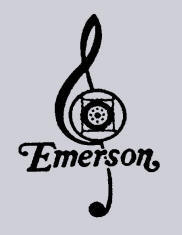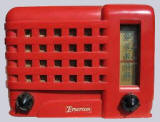|
|
|
|
|
Emerson Radio Corp. was
incorporated in 1915 as Emerson Phonograph
Co., based in New York City, by an early
recording engineer and executive, Victor
Hugo Emerson, who was at one time employed
by Columbia Records. The first factories
were opened in Chicago and Boston, in 1920.
In December of that year, the company fell
victim to the unanticipated sales slump for
phonograph music that accompanied the
post-World War I recession and the growth of
commercial radio. It went from the
self-claimed third largest record
manufacturer into receivership. |
 |
|
In 1922 Emerson Phonograph
Co. passed into the hands of Benjamin Abrams
and Rudolph Kanarak. Abrams, a phonograph
and record salesman, along with his two
brothers, ran the company and renamed it
Emerson Radio & Phonograph Corp in 1924,
after entering the radio business. The
company's record interests were sold.
Although Emerson introduced the first
radio-phonograph combination sold in the
United States, the company remained in
obscurity until 1932, when, during the Great
Depression, it introduced the "peewee" radio
(below). |
|
 |
Emerson Radio &
Phonograph converted to military
production for World War II in 1942,
when it held one-sixth of the U.S.
radio market. In 1943, it became a
public corporation. In 1947, among
its first post-war products, Emerson
offered a television set with a
10-inch tube. Although its ending
retail price was nearly equal to a
month's salary for the average
working American, it put Emerson at
the lower end of the market.
However, between fiscal 1948 and
1950, the high demand for television
allowed Emerson to more than double
its sales. |
|
|
In 1953 Emerson Radio and
Phonograph purchased Quiet Heet Corp., which
entered the company into air conditioning.
Although radio represented only 15 percent
of Emerson's revenue by 1954, the company
credited itself as creating the firsts of
the clock radio, self-powered radio, and
transistorized pocket radio; production of
tape recorders began in 1955. |
|
Emerson Radio and Phonograph
purchased the consumer products division of
DuMont Laboratories
in 1958. With this acquisition, a
higher-priced line of television sets,
phonographs and high-fidelity and stereo
instruments, along with the DuMont trademark
was added to Emerson's products.
Unfortunately, by this time, almost every
U.S. household that wanted a TV set already
had one, and many customers who were in need
of another set were waiting for colour
television instead of buying a replacement.
|
|
In 1965 the company acquired
the Pilot Radio Corp. Later in 1965 Emerson
Radio and Phonograph was purchased by
National Union Electric Corp. This company
continued to produce radios, television sets
and phonographs distributed under the
Emerson and
Dumont names and hi-fi
equipment
under the Pilot name. |
|
In late 1972 National Union
Electric announced that Emerson was
discontinuing distribution of television
sets and other home entertainment products.
In 1973 Emerson sold its license for
marketing products under the Emerson name to
Major Electronics Corp. In 1976 the company
moved its headquarters to
Secaucus,
New Jersey,
and changed its name to Emerson Radio Corp.
in 1977. |
|
In 1978, phonographs,
radios, tape recorders and players, compact
stereos, digital clock radios, and other low
to medium-priced electronic equipment was
being imported, assembled, and marketed,
primarily under the Emerson name. Emerson
Radio dropped its last U.S.-made product,
the phonograph line, in 1980 because it
became unprofitable due to rising labour
costs. |
|
In 1983 the company
reintroduced television sets. Emerson
purchased sets from Goldstar Electric Co.
(AKA
LG Electronics)
but sold them at a higher price. |
|
In 1984, Emerson signed a
10-year contract with
Orion
Electric to produce a line of VCRs
to its existing products. |
|
In 1985 a compact disc player
and microwave oven were introduced. Later
that year, Emerson Radio moved its
headquarters to North Bergen, New Jersey,
and acquired
H. H. Scott, Inc.,
a company that manufactured high-fidelity
audio and visual equipment. Products were
sold under the Scott name until 1991, the
year the line was discontinued. |
|
In 1986 Emerson began
importing and marketing compact
refrigerators and Hi-Fi stereo VHS VCRs.
Camcorders, telephones,
and answering machines were added to its
product line in 1988. In 1990 pcs and fax
machines were added for a major roll-out to
more than 500 Wal-Mart stores, but it ended
up being a catastrophe
for the company—a $150 million loss.
|
|
Fidenas Investment Ltd., a
Swiss firm based in the
Bahamas,
began purchasing shares of Emerson Radio
stock in 1989. Unfortunately, Emerson's
financial situation worsened. When the
company filed for bankruptcy in October
1993, Emerson had been in default on $223
million in debt for the previous two years. |
|
In 1994, the company emerged
from bankruptcy pursuant to a plan of
reorganization. In early 1995, in an effort
to cut costs, Emerson Radio licensed the
manufacture of certain video products under
the Emerson and G Clef trademarks for a
three-year period to Otake Trading Co. Ltd.
The company also licensed the sale of these
products in the United States and Canada for
the same period to
Wal-Mart
Stores, Inc. Also
in 1995, Emerson Radio entered the home
theater and car audio fields and the home
and personal security market with a carbon
monoxide detector. The company planned to
eventually lend its name to burglar alarms,
motion detectors, personal alarms, smoke
detectors,
and safety lights, however, the company left
this field in 1997. Additionally, Emerson
announced it would license the Emerson name
to more than 250 audio and video accessories
made by Jasco Products Co. |
|
Nearly 84 percent of its
merchandise in 1999 was imported, primarily
from
China, Hong Kong,
Malaysia, South Korea, and Thailand. Tonic
Electronics, Daewoo, and Imarflex were its
main suppliers. The company depended heavily
on Wal-Mart Stores,, and
Target
Stores, Inc. |
|
In 2001, Emerson exited the
video electronics business (TVs, DVD
players, VCRs) and handed 100% of the
operations to
Funai.
Funai currently makes and markets Emerson
consumer video products for Wal-Mart,
Sanlian licenced the Emerson brand for
additional product categories it finds
suitable for China-wide distribution and
cooperates with Emerson in the design,
development and sourcing for such. |
| Text from
article in Wikipedia |
|
|



